Peruvian food is famous for its taste and diversity. Every region has their own specialty. If you are in Peru I recommend you to try their local foods. Chicken, pork, lamb, fish ,rice and potatoes are the main ingredient of Peruvian foods. Fishes are abundant in Peru, so they are used with imagination. I hope you know potato is originated from Peru. So you will find plenty of dishes with potato, though in different form. Have you heard about 'Aji' ? This is the hot pepper Peruvians use in many dishes. Aji peppers are either red aji pepper or yellow aji pepper.
Peruvian traditional food are called Criollo dishes. Some Criollos are really very good. There are many types of dishes. Most of the Peruvian dishes you see in menu of the restaurants are Criollo dishes. I discussed here some of the Peruvian foods.
Ceviche- Ceviche can be cooked and served 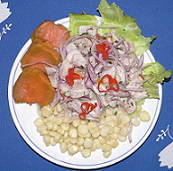 in different styles. In Almost every restaurant you will find one version of Ceviche. In its classical version, Ceviche is a very simple dish. You need fresh sliced fish, freshly squeezed lime juice, sliced onions, salt and chile (aji limo or rocoto). Sea bass is a preferred fish for Ceviche. The fish is always marinated in lime juice, onions and chilies. Most cases they serve Ceviche with boiled sweet potatoes or corn.
in different styles. In Almost every restaurant you will find one version of Ceviche. In its classical version, Ceviche is a very simple dish. You need fresh sliced fish, freshly squeezed lime juice, sliced onions, salt and chile (aji limo or rocoto). Sea bass is a preferred fish for Ceviche. The fish is always marinated in lime juice, onions and chilies. Most cases they serve Ceviche with boiled sweet potatoes or corn. 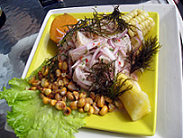
In many restaurants a small glass of leche de tigre or leche de pantera is served as an appetizer, after Ceviche. The name looks difficult to understand, but actually it just the lime juice marinade. Here on the left you van see two different versions of Ceviche.
Jalea - Jalea is a fried, lightly breaded fish, or seafood dish, which is very popular in Peru. There are mainly three types of Jalea- Jalea de Mariscos,· Jalea de Pescado and Jalea de Pota. Actually Jalea means Jelly, so the these three mean; Jelly seafood, Jelly Fish and Jelly Pota. For Jalea de Pescado fish fillets cut into pieces and cooked with salt, and peeper. Corns are used to cover the food while cooking. Finally squeezed lemon is used and served. For Jalea de Mariscos shellfishs are most cases used. Also quid, snails, shells fan, choros and machas are more used instead of fish.
Tiradito- This food is a bit like Ceviche. In Ceviche chunk fishes are used , but in this dish fish fillets are used. strips of fish marinated in lemon juice. In this dish less onion is used.
Cuy- Cuy is also called as Cobayo or conejillo de indias. People from outside Peru are 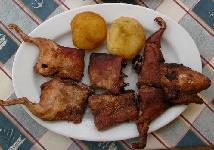 sometimes astonished with the scene of a Cuy at their plate. It is the whole Guinea pig roasted. The taste may be delicious but as it a pet to many countries, it is difficult to consume the food or even the idea of eating it. Coy is served whole (head, paws and all) on a platter with potatoes and vegetables. Sometimes it is cut into pieces and served, but most cases it is served as a whole. It may taste like chicken, but it has a gamey flavor which is of its own. In Peru this guinea pigs are a bit large, almost like a large rat. But you will find them skinny and there’s often not a lot of meat you will find on them. It was the food for Inca royalty. So you may try it for at least once!
sometimes astonished with the scene of a Cuy at their plate. It is the whole Guinea pig roasted. The taste may be delicious but as it a pet to many countries, it is difficult to consume the food or even the idea of eating it. Coy is served whole (head, paws and all) on a platter with potatoes and vegetables. Sometimes it is cut into pieces and served, but most cases it is served as a whole. It may taste like chicken, but it has a gamey flavor which is of its own. In Peru this guinea pigs are a bit large, almost like a large rat. But you will find them skinny and there’s often not a lot of meat you will find on them. It was the food for Inca royalty. So you may try it for at least once!
Anticuchos- This dish is popular throughout the whole south America. But probably it is most popular in Peru. If you have ever visited India or Bangladesh you may have eaten this food there, named as Shick Cabab. This food was popular during Inca period. It remains popular in last few centuries.
In this dish small pieces of meat first marinated with vinegar and different spices. then pieces are skewered to sticks. Different meats are used in different places and cases. Cows heart is popular most as meat.
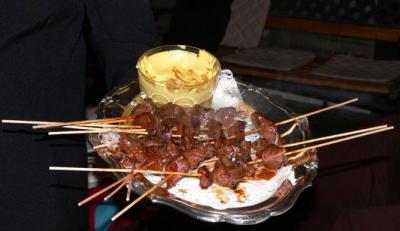
Popular Anticuchos dish
Best thing about this dish is that you can eat this item even at street in Peru. People eat Anticuchos from street carts or street stalls. Price is also very cheap.
Coctel de camarones - This one is a cocktail of shrimp and served as cold. They use shrimp and lime juice to prepare this dish.
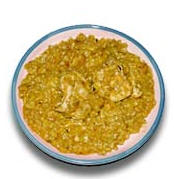
Carapulca - Carapulca is one of Peru's most ancient dishes. The name Carapulca came from Kalas, which was the stone used for cooking this item. In those days it was prepared with dried meat and dried potato. Now a days it is made from dried and diced potatoes with pork and rice.
Tacu-tacu - This dish is a bit different than other dishes. Main ingredients are rice, bean, egg, onion and banana. Tacu-tacu is not that ancient, rather originated from African plantation workers who worked in the south Lima fields. Some restaurants use seafood as a main ingredient along with chili sauce and of course aji.
Arroz con pollo - Arroz con pollo or rice with chicken, is enjoyed for its rich-flavored rice combined with chicken.
Lomo saltado - Lomo Saltado is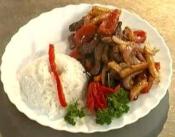 one of the most popular menu at local restaurants. It is a dish of marinated beef steak, fried potatoes and vegetables. This dish is served with white plain rice. If you like this food, then good news is that you can find this dish even in smaller restaurants, and at a affordable price. Lomo saltado can be cooked in different ways, so may find different versions in different restaurants.
one of the most popular menu at local restaurants. It is a dish of marinated beef steak, fried potatoes and vegetables. This dish is served with white plain rice. If you like this food, then good news is that you can find this dish even in smaller restaurants, and at a affordable price. Lomo saltado can be cooked in different ways, so may find different versions in different restaurants.
Cau cau 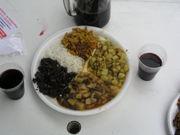 Cau Cua is another popular dish in Peru. There are several types of Cau cau. In all cases they use tripe stew and it is served with rice. In most places you will see either Creole style Cau cau (or called Tripe Cau-cau) or Italian-Peruvian style Cau cau. In creale style they use mixture of sautéed onions, yello aji, sautéed onions and sliced boiled potatoes. While in Italian style they use red onions, peeled tomatoes, dried mushrooms. Here fried potatoes are mixed just before serving. When the food was sautéed they may add a tablespoon of pisco.
Cau Cua is another popular dish in Peru. There are several types of Cau cau. In all cases they use tripe stew and it is served with rice. In most places you will see either Creole style Cau cau (or called Tripe Cau-cau) or Italian-Peruvian style Cau cau. In creale style they use mixture of sautéed onions, yello aji, sautéed onions and sliced boiled potatoes. While in Italian style they use red onions, peeled tomatoes, dried mushrooms. Here fried potatoes are mixed just before serving. When the food was sautéed they may add a tablespoon of pisco.
Arroz con pato- If you know the meaning of 'Arroz' and 'Pato', you know what this food is. Arroz means rice and Pato is duck. So if you like duck, this is the dish for you. In this dish rice is not plain white rice. Rice is cooked with other ingredients.
Chupe de camarones- Chupe de camarones (shrimp cioppino) is one of the most popular dishes of Peruvian cuisine. Main ingredient here is freshwater shrimp (crayfish) stock soup. In this dish milk and chili pepper are added, and served with potatoes. This dish is originated from Arequipa. In most of the restaurants you will find it.
Aji de Gallina- Gallina is nothing but hen. So if you like chicken then you may like this dish. Shredded chicken is used for this dish. Other ingredients are milk, cheese, chilies, garlic and onions. It is served with rice.





 in different styles. In Almost every restaurant you will find one version of Ceviche. In its classical version, Ceviche is a very simple dish. You need fresh sliced fish, freshly squeezed lime juice, sliced onions, salt and chile (aji limo or rocoto). Sea bass is a preferred fish for Ceviche. The fish is always marinated in lime juice, onions and chilies. Most cases they serve Ceviche with boiled sweet potatoes or corn.
in different styles. In Almost every restaurant you will find one version of Ceviche. In its classical version, Ceviche is a very simple dish. You need fresh sliced fish, freshly squeezed lime juice, sliced onions, salt and chile (aji limo or rocoto). Sea bass is a preferred fish for Ceviche. The fish is always marinated in lime juice, onions and chilies. Most cases they serve Ceviche with boiled sweet potatoes or corn. 
 sometimes astonished with the scene of a Cuy at their plate. It is the whole Guinea pig roasted. The taste may be delicious but as it a pet to many countries, it is difficult to consume the food or even the idea of eating it. Coy is served whole (head, paws and all) on a platter with potatoes and vegetables. Sometimes it is cut into pieces and served, but most cases it is served as a whole. It may taste like chicken, but it has a gamey flavor which is of its own. In Peru this guinea pigs are a bit large, almost like a large rat. But you will find them skinny and there’s often not a lot of meat you will find on them. It was the food for Inca royalty. So you may try it for at least once!
sometimes astonished with the scene of a Cuy at their plate. It is the whole Guinea pig roasted. The taste may be delicious but as it a pet to many countries, it is difficult to consume the food or even the idea of eating it. Coy is served whole (head, paws and all) on a platter with potatoes and vegetables. Sometimes it is cut into pieces and served, but most cases it is served as a whole. It may taste like chicken, but it has a gamey flavor which is of its own. In Peru this guinea pigs are a bit large, almost like a large rat. But you will find them skinny and there’s often not a lot of meat you will find on them. It was the food for Inca royalty. So you may try it for at least once!

 one of the most popular menu at local restaurants. It is a dish of marinated beef steak, fried potatoes and vegetables. This dish is served with white plain rice. If you like this food, then good news is that you can find this dish even in smaller restaurants, and at a affordable price. Lomo saltado can be cooked in different ways, so may find different versions in different restaurants.
one of the most popular menu at local restaurants. It is a dish of marinated beef steak, fried potatoes and vegetables. This dish is served with white plain rice. If you like this food, then good news is that you can find this dish even in smaller restaurants, and at a affordable price. Lomo saltado can be cooked in different ways, so may find different versions in different restaurants. Cau Cua is another popular dish in Peru. There are several types of Cau cau. In all cases they use tripe stew and it is served with rice. In most places you will see either Creole style Cau cau (or called Tripe Cau-cau) or Italian-Peruvian style Cau cau. In creale style they use mixture of sautéed onions, yello aji, sautéed onions and sliced boiled potatoes. While in Italian style they use red onions, peeled tomatoes, dried mushrooms. Here fried potatoes are mixed just before serving. When the food was sautéed they may add a tablespoon of pisco.
Cau Cua is another popular dish in Peru. There are several types of Cau cau. In all cases they use tripe stew and it is served with rice. In most places you will see either Creole style Cau cau (or called Tripe Cau-cau) or Italian-Peruvian style Cau cau. In creale style they use mixture of sautéed onions, yello aji, sautéed onions and sliced boiled potatoes. While in Italian style they use red onions, peeled tomatoes, dried mushrooms. Here fried potatoes are mixed just before serving. When the food was sautéed they may add a tablespoon of pisco.